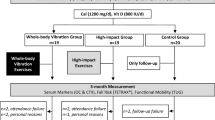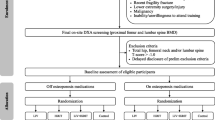Abstract
Summary
We determined whether the effect of exercise on bone mineral density (BMD) and falls can be enhanced by whole body vibration (WBV). In summary, the multi-purpose exercise training was effective to increase lumbar BMD but added WBV did not enhance this effect. However, falls were lowest in the exercise program combined with WBV.
Introduction
WBV is a new approach to reduce the risk of osteoporotic fractures. In the “Erlangen Longitudinal Vibration Study” (ELVIS), we investigated whether WBV enhances the effect of multifunctional exercise on BMD and falls.
Methods
One hundred fifty-one postmenopausal women (68.5 ± 3.1 years) were randomly assigned to a: (1) conventional training group (TG); (2) conventional training group including vibration (TGV); and (3) wellness control group (CG). TG conducted an exercise program consisting of 20 min dancing aerobics, 5 min balance training, 20 min functional gymnastics, and 15 min dynamic leg-strength training on vibration plates (without vibration) twice a week. TGV performed an identical exercise regimen with vibration (25–35 Hz) during the leg-strengthening sequence. CG performed a low-intensity wellness program. BMD was measured at the hip and lumbar spine at baseline and follow-up using the DXA method. Falls were recorded daily via the calendar method.
Results
After 18 months, an increase in BMD at the lumbar spine was observed in both training groups (TGV: +1.5% vs. TG: +2.1%). The difference between the TG and the CG (1.7%) was significant. At the hip no changes were determined in either group. The fall frequency was significantly lower in TGV (0.7 falls/person) compared with CG (1.5), whereas the difference between TG (0.96) and CG was not significant.
Conclusions
A multifunctional training program had a positive impact on lumbar BMD. The application of vibration did not enhance these effects. However, only the training including WBV affected the number of falls significantly.

Similar content being viewed by others
References
Gillespie LD, Robertson MC, Gillespie WJ, Lamb SE, Gates S, Cumming RG, Rowe BH (2009) Interventions for preventing falls in older people living in the community. Cochrane Database Syst Rev (2):CD007146
von Stengel S, Kemmler W, Pintag R, Beeskow C, Weineck J, Lauber D, Kalender WA, Engelke K (2005) Power training is more effective than strength training for maintaining bone mineral density in postmenopausal women. J Appl Physiol 99:181–188
Guadalupe-Grau A, Fuentes T, Guerra B, Calbet JA (2009) Exercise and bone mass in adults. Sports Med 39:439–468
Palombaro KM (2005) Effects of walking-only interventions on bone mineral density at various skeletal sites: a meta-analysis. J Geriatr Phys Ther 28:102–107
Kemmler W, von Stengel S, Weineck J, Lauber D, Kalender W, Engelke K (2005) Exercise effects on menopausal risk factors of early postmenopausal women: 3-yr Erlangen fitness osteoporosis prevention study results. Med Sci Sports Exerc 37:194–203
Kallinen M, Markku A (1995) Aging, physical activity and sports injuries. An overview of common sports injuries in the elderly. Sports Med 20:41–52
Rubin C, Xu G, Judex S (2001) The anabolic activity of bone tissue, suppressed by disuse, is normalized by brief exposure to extremely low-magnitude mechanical stimuli. FASEB J 15:2225–2229
Rubin C, Turner AS, Mallinckrodt C, Jerome C, McLeod K, Bain S (2002) Mechanical strain, induced noninvasively in the high-frequency domain, is anabolic to cancellous bone, but not cortical bone. Bone 30:445–452
Gilsanz V, Wren TA, Sanchez M, Dorey F, Judex S, Rubin C (2006) Low-level, high-frequency mechanical signals enhance musculoskeletal development of young women with low BMD. J Bone Miner Res 21:1464–1474
Gusi N, Raimundo A, Leal A (2006) Low-frequency vibratory exercise reduces the risk of bone fracture more than walking: a randomized controlled trial. BMC Musculoskelet Disord 7:92
Rubin C, Recker R, Cullen D, Ryaby J, McCabe J, McLeod K (2004) Prevention of postmenopausal bone loss by a low-magnitude, high-frequency mechanical stimuli: a clinical trial assessing compliance, efficacy, and safety. J Bone Miner Res 19:343–351
Verschueren SM, Roelants M, Delecluse C, Swinnen S, Vanderschueren D, Boonen S (2004) Effect of 6-month whole body vibration training on hip density, muscle strength, and postural control in postmenopausal women: a randomized controlled pilot study. J Bone Miner Res 19:352–359
Roelants M, Delecluse C, Goris M, Verschueren S (2004) Effects of 24 weeks of whole body vibration training on body composition and muscle strength in untrained females. Int J Sports Med 25:1–5
Russo CR, Lauretani F, Bandinelli S, Bartali B, Cavazzini C, Guralnik JM, Ferrucci L (2003) High-frequency vibration training increases muscle power in postmenopausal women. Arch Phys Med Rehabil 84:1854–1857
Sigrist M, Lammel C, Jeschke D (2006) Krafttraining an konventionellen bzw. oszillierenden Geräten und Wirbelsäulengymnastik in der Prävention der Osteoporose bei postemenopausalen Frauen. Dtsch Z Sportmed 57:182–188
Verschueren S, Bogaerts A, Delecluse C, Claessens AL, Boonen S (2006) Effects of one year vibration loading on muscle strength and hip density in postmenopausal women. J Bone Miner Res 21:(Suppl):S152
von Stengel S, Kemmler W, Mayer S, Engelke K, Kalender WA (2009) Effect of whole body vibration exercise on osteoporotic risc factors. Dtsch Med Wochenschr 30:1511–1516
von Stengel S, Kemmler W, Engelke K, Kalender W (2010) Effect of whole body vibration on neuromuscular performance and body composition for females 65 years and older. Scand J Med Sci Sports accepted for publication
Tothill P, Hannan WJ (2007) Precision and accuracy of measuring changes in bone mineral density by dual-energy X-ray absorptiometry. Osteoporos Int 18:1515–1523
Lamb SE, Jorstad-Stein EC, Hauer K, Becker C (2005) Development of a common outcome data set for fall injury prevention trials: the prevention of falls network Europe consensus. J Am Geriatr Soc 53:1618–1622
Mori S, Tuji S, Kawamoto M, Yamada E, Miyamato K, Tanaka S, Manabe T, Maschiba T, Yamamoto T (2006) Six month whole body vibration exercises improves leg muscle strength, balance as well as calcaneal bone mineral density of community dwelled elderly. J Bone Miner Res 21(Suppl):S249
Runge M, Rehfeld G, Resnicek E (2000) Balance training and exercise in geriatric patients. J Musculoskelet Neuronal Interact 1:61–65
Bautmans I, Van Hees E, Lemper JC, Mets T (2005) The feasibility of whole body vibration in institutionalised elderly persons and its influence on muscle performance, balance and mobility: a randomised controlled trial. BMC Geriatr 5:17
Bruyere O, Wuidart MA, Di Palma E, Gourlay M, Ethgen O, Richy F, Reginster JY (2005) Controlled whole body vibration to decrease fall risk and improve health-related quality of life of nursing home residents. Arch Phys Med Rehabil 86:303–307
Kelley GA (1998) Exercise and regional bone mineral density in postmenopausal women: a meta-analytic review of randomized trials. Am J Phys Med Rehabil 77:76–87
Kemmler W, Engelke K (2004) A critical review of exercise training on bone mineral density in postmenopausal women. Int Sportmed J 5:67–77
Wallace BA, Cumming RG (2000) Systematic review of randomized trials of the effect of exercise on bone mass in pre- and postmenopausal women. Calcif Tissue Int 67:10–18
Wolff I, van Croonenborg JJ, Kemper HC, Kostense PJ, Twisk JW (1999) The effect of exercise training programs on bone mass: a meta-analysis of published controlled trials in pre- and postmenopausal women. Osteoporos Int 9:1–12
Rubin C, Judex S, Qin YX (2006) Low-level mechanical signals and their potential as a non-pharmacological intervention for osteoporosis. Age Ageing 35(Suppl):2:ii32–ii36
Sehmisch S, Galal R, Kolios L, Tezval M, Dullin C, Zimmer S, Stuermer KM, Stuermer EK (2009) Effects of low-magnitude, high-frequency mechanical stimulation in the rat osteopenia model. Osteoporos Int 10:892–893
Xie L, Rubin C, Judex S (2008) Enhancement of the adolescent murine musculoskeletal system using low-level mechanical vibrations. J Appl Physiol 104:1056–1062
Yang P, Jia B, Ding C, Wang Z, Qian A, Shang P (2009) Whole-body vibration effects on bone before and after hind-limb unloading in rats. Aviat Space Environ Med 80:88–93
Ruan XY, Jin FY, Liu YL, Peng ZL, Sun YG (2008) Effects of vibration therapy on bone mineral density in postmenopausal women with osteoporosis. Chin Med J (Engl) 121:1155–1158
Abercromby AF, Amonette WE, Layne CS, McFarlin BK, Hinman MR, Paloski WH (2007) Vibration exposure and biodynamic responses during whole-body vibration training. Med Sci Sports Exerc 39:1794–1800
Kiiski J, Heinonen A, Jarvinen TL, Kannus P, Sievänen H (2008) Transmission of vertical whole body vibration to the human body. J Bone Miner Res 23:1318–1325
Acknowledgment
This work was supported by the Elsbeth Bonhoff foundation, Germany, and Siemens Betriebskrankenkasse (SBK) Erlangen, Germany. We gratefully acknowledge the help of Opfermann (Wiehl, Germany) who supplied Ca and Vit-D (CALCIGEN®). Further we thank mtd-Systems® (Neuburg v. Wald, Germany), who supplied the force measuring plates and the BVS Boyern.
Conflicts of interest
None.
Author information
Authors and Affiliations
Corresponding author
Additional information
As corresponding author I take responsibility for the work as a whole, from the inception to the published article.
Rights and permissions
About this article
Cite this article
von Stengel, S., Kemmler, W., Engelke, K. et al. Effects of whole body vibration on bone mineral density and falls: results of the randomized controlled ELVIS study with postmenopausal women. Osteoporos Int 22, 317–325 (2011). https://doi.org/10.1007/s00198-010-1215-4
Received:
Accepted:
Published:
Issue Date:
DOI: https://doi.org/10.1007/s00198-010-1215-4




